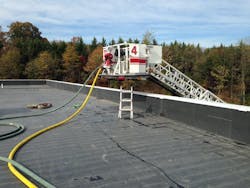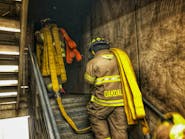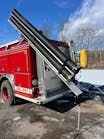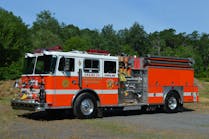The Flying Standpipe
At the heart of every engine company operation is the hoseline. The primary mission of the engine company is to stretch and advance the hoseline into position and launch an attack on the fire. In most cases, the largest obstacle in the path of the hoseline operation is a stairway that must be ascended. Ascending a stairway and managing the pinch points associated with the stairway are typically easily overcome by the engine company firefighters, and the hoseline operation is performed without fault.
Hoseline-advancement obstacles
One of the simplest methods of advancing a charged hoseline up a stairway is the use of the technique known as building a bow. Building a bow consists of the nozzle firefighter being positioned at the base of the stairway and advancing the hoseline up the stairway in the shape of a bow. This technique is also referred to a rolling the hoseline up the stairway.
To perform this operation, the nozzle firefighter should position the nozzle underneath their knee or foot to ensure that control of the nozzle is maintained throughout the operation. The nozzle firefighter then advances the hoseline up the stairway by guiding it up the wall on the opposite side in which the nozzle firefighter intends to exit the stairway as the backup firefighter feeds hoseline to the nozzle firefighter in the form of slack. The nozzle firefighter can then easily ascend the stairway with the nozzle.
Some building stairways were clearly not designed with firefighting operations in mind. These stairways may be narrow in width and short in the depth of the steps or contain many turns. A commonly used tactic to overcome these obstacles is for firefighters to ascend the stairway without a hoseline to the floor below the fire. The firefighters then drop a utility rope out of a window and down to a firefighter positioned in the street or yard of the building where the utility rope is used to secure the hoseline to be hoisted. The firefighters on the floor below the fire floor then hoist the hoseline up the face of the building and into the building. This tactic limits the number of floors of the stairway that the firefighters must advance the hoseline. The stairway will not always be the largest obstacle in the path of an advancing team of firefighters. Sometimes an extremely long hoseline stretch and advancement operation can be required at a variety of fire scenes. This may be due to the design or location of the building or be required in buildings that may contain damaged or out-of-service standpipe systems
Multi-level structures that do not possess a standpipe system also pose challenges. One example: multi-level parking garages. Most fire apparatus cannot fit into these structures and therefore must remain in the street.
Standpipe solution
The flying standpipe operation is a tactic that can be employed in each of the scenarios to assist firefighters in getting the hoseline into position in a timely and effective manner. The flying standpipe operation is the use of an aerial ladder to provide a water supply for hoseline operations. It can be employed to assist firefighters in getting the hoseline into position in a timely and effective manner. The flying standpipe operation includes the use of a tower ladder that possesses a discharge outlet in the platform. If this type of aerial apparatus is present, a flying standpipe operation can be performed to assist firefighters in getting the hoseline into position.
To perform a flying standpipe operation, the aerial apparatus must be positioned so that the aerial ladder can be raised and positioned in a position where the hoseline stretch and advancement operation can be performed. In the case of a building, this position will be the floor below the fire in a location near a stairway that can be used by the firefighters to access the fire floor.
In the event of a vehicle fire or multiple vehicle fires in a structure such as a parking garage, the proper position for the aerial ladder will be on the fire floor in a position near the location of the fire. This positioning enables firefighters to perform a shorter hose stretch and advancement operation as well as providing an additional means of access and egress to firefighters.
Flying standpipe and ship fires
Fires do not always occur in easily accessible areas. A good example of this is fires that occur aboard ships. Firefighters must find a way to stretch and advance the hoselines that will be needed for the fire attack operation. The ship’s gangway is not a favorable location to perform a hoseline stretch and advancement operation for multiple reasons, including its small size, its non-permanently secured status and the fact that it is the only evacuation route for occupants of the ship.
In the event of a fire aboard a ship, the proper location for the aerial ladder is opposite of the gangway. Opposite of the gangway does not mean on the water side of the ship but instead refers to either forward (front of the ship) or aft (rear of the ship) positioning on the ship. By positioning the aerial ladder opposite of the gangway, occupants of the ship can evacuate using the ship’s gangway and the firefighters can access the ship using the aerial ladder. Like designating separate stairways for fire attack and evacuation operations at fires in multi-story buildings, positioning the aerial ladder opposite of the ship’s gangway allows for fire attack operations and occupant evacuation operations to be separated, preventing congestion along the path of travel that would slow down both operations.
Once the aerial ladder is in position, the hoseline can be connected to the discharge outlet in the platform of the ladder. The hoseline can then be charged by the operator of the aerial apparatus through the apparatus’s pre-pipped waterway. The operator must account for the pressure needs of the hoseline as well as the pressure lost in the waterway of the aerial ladder if the hoseline is to be provided with the correct pressure. In order to supply the correct pressure, the operator must be informed of the size of the hoseline being used, the length of the hoseline and the nozzle being used.
Firefighters can utilize an inline pressure gauge when performing a flying standpipe operation in the same way that an inline pressure gauge is used during standpipe operations to ensure proper pressurization of the hoseline. To use an inline pressure gauge, firefighters connect it to the discharge outlet of the aerial ladder and then connect the hoseline to the inline pressure gauge. Once charged, the hoseline operation can be performed in the same manner as any other hoseline operation.
A flying standpipe operation can also be performed using an aerial apparatus that does not possess a pre-pipped waterway by stretching a hoseline up the aerial ladder with a gated wye attached to the end that the fire attack hoseline can be connected to. When possible, an aerial apparatus that possess a pre-pipped waterway and a discharge outlet at the tip of the ladder should be used as it is much less manpower dependent. Stretching a hoseline up an aerial ladder is both a manpower dependent and a manpower depleting operation.
An added benefit of the flying standpipe operation is that at fires where accessibility is an issue, it provides an additional route of access and egress. It also improves firefighter safety by providing a much safer route of travel for firefighters transporting equipment. On a ship fire, transporting equipment from the dock to the deck of the ship via the ship’s gangway can be a dangerous operation as the gangway is not a steady route of travel as it is constantly moving and is minimal in size. When a flying standpipe operation is performed, the equipment can be transported from the dock to the deck via the aerial ladder.
While firefighters can carry the equipment up the aerial ladder once the aerial ladder has been raised into position, the best course of action is to have a crew of firefighters raised from the dock to the deck of the ship via the aerial ladder. The aerial ladder is then lowered back down and the firefighting equipment is then loaded into the platform. The firefighting equipment can then be handed from the aerial ladder to firefighters positioned on the deck of the ship. The hoselines can then be connected to the discharge outlet of the aerial ladder and charged with water. Additional firefighters can then ascend the aerial ladder rather than the ship’s gangway to access the ship.
Weigh the pros and cons
Like any other operation, firefighters must compare the pros and cons of performing a flying standpipe operation before deciding to employ it. The pros are that the operation provides a water supply for hoseline operations like those mentioned above. It will also provide an additional means of access and egress for firefighters in these situations. The flying standpipe operation can also reduce the strain placed on the limited resources available on the fire scene to transport equipment to the fire area. This is especially true of fire aboard ships.
On the con side, performing a flying standpipe eliminates the ability of the aerial ladder to be used for other operations including rescue and ventilation. This is of particular importance when fire departments only send a single aerial apparatus to a fire. Anytime a flying standpipe operation is performed, regardless of the number of aerial apparatus that are on scene at the time, an additional aerial apparatus must be requested. The flying standpipe operation should be a last resort tactic when a single aerial apparatus is on scene.
Firefighters must always be prepared to overcome any obstacles that may impede the effectiveness of an operation. The flying standpipe operation is a tactic that can be used to overcome some obstacles to hoseline operations, particularly when accessibility is limited. While the flying standpipe operation will not always be the best option to get the hoseline into position, particularly when the availability of aerial apparatus is limited, the tactic is a great tool that can be very beneficial specifically when access is limited.
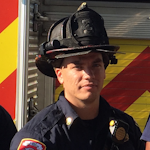
Anthony Rowett Jr.
ANTHONY ROWETT Jr. is a captain with the Mobile, AL, Fire Rescue Department. He was previously a firefighter with the Ogdensburg, NJ, Fire Department. Rowett has an associate’s degree in fire science technology from County College of Morris, NJ, a bachelor’s degree in fire science, and a master’s degree in emergency services management. He is a contributing author for multiple fire service publications and has presented at multiple fire service conferences. He has also served as a lead HOT instructor for a hoseline operations class at the Metro Atlanta Fire Fighters Conference. Rowett is the founder of Port City Fire Training. He can be reached at [email protected].
